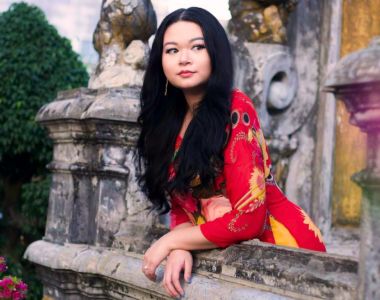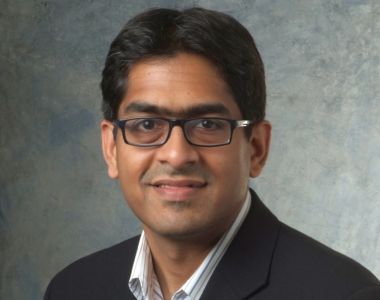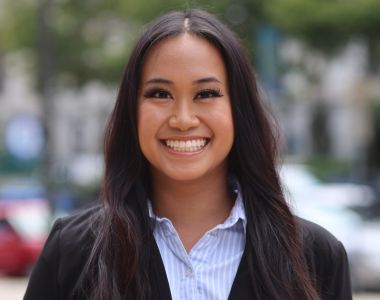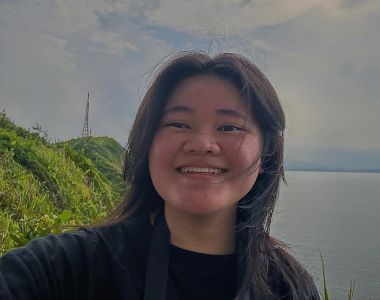From supporting students through the Office of Interprofessional and Interdisciplinary Education and Research, to teaching in multiple departments and studying international relations, those of Asian, Pacific Islander, Desi and Asian American heritage are engaged with countless facets of Case Western Reserve University.
In recognition of Asian, Pacific Islander, Desi and Asian American (APIDAA) Heritage Month, which takes place annually in May, The Daily is celebrating the accomplishments and experiences of four APIDAA members of the CWRU community. Discover more about their experiences at the university—and learn how their heritage has impacted their lives.
Answers have been lightly edited for clarity and length.

Elizabeth Dang
Program manager, Office of Interprofessional and Interdisciplinary Education and Research, Health Education Campus
Q: Why are you passionate about your role at CWRU? Do you share your culture with any of your colleagues or students?
Dang: Although I am new to my role and to the institution, having joined in March, I am passionate about supporting students to navigate their educational journeys in higher education. As a first-generation college student, I can relate to the struggles that many students face when embarking on this journey for the first time. As I am still adjusting to the role, I have not yet shared my culture with my colleagues and students as much as I would like to, but I have done so in small ways so far. My email signature has the correct tone marks of my last name (Đặng) which is an acknowledgment of my traditional family name. The desk pad for my workstation is custom printed art depicting a screen view of Saigon from the past by artist Kha Liem. I still need to decorate my office more, where I would love to include bits of my culture. I would also like to show my colleagues different aspects of my culture, like our popular Vietnamese coffee or cà phê sữa đá.
Q: What has your career path looked like so far?
Dang: My career path has been a rollercoaster of a journey. Like many other Vietnamese American families, my employment path started in my family’s nail salon. I also had short bits of employment in our (since closed) family-owned local restaurant, Saigon Grille. When I started college, I became heavily involved in APIDAA-related student organizations which opened my eyes to a passion for serving students. My graduate school journey solidified my passion for higher education and led me to my first full-time role as the coordinator of a university APIDAA Cultural Center in Arizona. My family is primarily based in Cleveland so I made the difficult decision to move back home to the Midwest where I then landed this role as a program manager. I have thoroughly enjoyed my time in this role so far being part of an impactful team doing great work for the campus community.
Q: What do you think the campus community should know about APIDAA Month or APIDAA heritage in general?
Dang: What the campus community should know is something that has been echoed for a long time: there is a plethora of diversity that cannot be contained in a few letters of the acronym. When disaggregated, there is a wealth of cultural differences that make every ethnicity and culture unique and it is a disservice to us all if those differences are not recognized. Every group has a unique history, culture, and perspective so it is important to understand that although we may share similarities, there are disparities that are revealed when the data is disaggregated.
Q: Why do you believe it’s important to celebrate APIDAA Month?
Dang: Like any other heritage or history month that is dedicated to a minority group, this is a time to reflect on history, be mindful of where we are in the present, and work toward building an equitable future of understanding and celebration. Heritage months are an important opportunity to learn more about the community and come to a better understanding of one another. To me, we are not a melting pot, but a stained glass window where each culture can be acknowledged and is extremely beautiful when all brought together.
Q: Where is your family from? Where did you grow up?
Dang: My ancestors are from Việt Nam, a beautiful country that I have had the privilege to visit a few times in my life. My parents immigrated to the U.S. as refugees from the war, where they planted their roots in Atlanta, Georgia, and had my brothers and I. Our family moved around a lot and eventually relocated to Cleveland, where we have been ever since. My most recent trip back to the motherland was this past winter to attend the funeral of my bà nội (paternal grandmother). I had not visited in about 13 years and this time I was able to enjoy the country as an adult with more appreciation for my culture and the ability to make meaning of my experiences there. The happiest and most free I have felt on that trip was riding passenger on the back of a motorbike as I sailed through the cities and took in the sights and sounds of the busy streets. I felt nothing but pride for my culture and identity during that trip and I long for the next time I can visit again.

Satish Viswanath
Associate professor, Department of Biomedical Engineering, Department of Radiology, Department of Electrical, Computer and Systems Engineering
Q: Why are you passionate about your role at CWRU? Do you share your culture with any of your colleagues or students?
Viswanath: My role at CWRU reflects a core tenet of my life and career so far: multi-faceted integration. My passion for my roles at the university as an associate professor of BME and co-director of the Center for AI Enabling Discovery in Disease Biology (AID2B) stems from how they represent integration of different aspects of science and engineering to impact human health. CWRU has an amazing community where I have not only found welcoming folks interested in learning about my culture and background but also a home for a similar community of first-generation immigrants from India (such as myself). This has given me many avenues through which to share my culture and experiences with a wide audience and, indeed, integrate with a broad swathe of backgrounds.
Q: What has your career path looked like so far?
Viswanath: My career path involved wide-ranging experiences. By the age of 25, I had already lived in three different countries and experienced a variety of cultures in different settings—as a student, as a tourist, and as an immigrant. I joined CWRU as a faculty member soon after graduating my PhD and found a home where I have had the opportunity to learn and grow every day. My career at CWRU has allowed me an exponential progression in the types of research and problems to work on, and a deeply collaborative milieu to enable success.
Q: What do you think the campus community should know about APIDAA Month or APIDAA heritage in general?
Viswanath: APIDAA heritage is a rich tapestry of many different ethnicities and cultures which share many things in common with each other, while also encompassing fascinating aspects of human history. I think this is an excellent opportunity for us all to learn more about APIDAA heritage, toward becoming a closer knit community. This could include participating in the Cleveland Asian Festival, checking out the special Asian exhibits ongoing at nearby museums, as well as connecting with the different APIDAA communities and clubs on campus to celebrate together.
Q: Why do you believe it’s important to celebrate APIDAA Month?
Viswanath: Any minority group appreciates the opportunity for recognition as a part of the broader society. This kind of event not only helps the APIDAA community feel “adopted” into the broader milieu but it helps society at large learn more about each other, understand differences, and celebrate our diversity. Personally speaking, I appreciate the fact that such events help my children gain a deeper understanding of their roots; it helps them maintain our unique identity and feel proud of the culture they are from.
Q: Where is your family from? Where did you grow up?
Viswanath: I am originally from India, and a majority of my immediate relatives still live there. I grew up in Dubai (in the Middle East) as well as in Mumbai (in India). My family and I try to visit India regularly to see our parents and siblings at least once a year, as well as give my children a chance to connect with some part of their roots in India. Cleveland is also unique in offering multiple touch points to experience different facets of Indian culture—including the music, the food, and the celebrations.

Kintan Silvany
Rising fourth-year student, international relations and education
Q: Why did you choose to study international relations and education?
Silvany: I chose to study this in order to connect to my culture through academia. I knew that I would have more flexibility in international studies and I have always wanted to become a teacher since my mother is one. Through my major, I have been able to study abroad and learn the Indonesian language and history. I intend to work in the field of Indonesian and American relations, whether it be organizations like UNICEF, at the Indonesian embassy in the United States, or teaching in Indonesia!
Q: What do you think the campus community should know about APIDAA Month or APIDAA heritage in general?
Silvany: I think that it is very important to embrace the diversity of APIDAA heritage. Not one culture is alike and there is so much to explore and learn about. Some people have a very small perception of what “Asia” is, but in reality, it is so much more.
Q: Why do you believe it’s important to celebrate APIDAA Month?
Silvany: I believe it’s important to celebrate APIDAA Month because you need to honor your past and realize how it contributes to your present self. Your culture and heritage are what made you the person you are today and it is crucial to honor that. I personally commit to Indonesian dance in order to honor my culture! It has been a great bridge for me to learn more about Indonesian traditions.
Q: Where is your family from? Where did you grow up?
Silvany: My family is originally from Surabaya, Indonesia. We are of Javanese descent. They immigrated to America 22 years ago. I was born and raised in the heart of Philadelphia, Pennsylvania.

Amanda Wu
Third-year studying international studies and political science
Q: Why did you choose to study international studies and political science?
Wu: I initially chose to study international studies coming into CWRU. I knew I wanted an interdisciplinary or multidisciplinary major, and international studies offered tons of opportunities to learn more about the world around me. Additionally, I really wanted to find a career that would help or serve others in whatever capacity possible. Despite being in intro-level political science courses (which often earn a reputation due to the nature of being an intro-level political science course), I noticed that there were substantial opportunities both on the grassroots, community-level and on the international level. This really appealed to me, so I simply continued and never stopped.
Q: What do you think the campus community should know about APIDAA Month or APIDAA heritage in general?
Wu: Right now especially, Asian-Americans are gaining more representation, not just in mainstream media but in every level of society. I think there’s an important question to address within the APIDAA community, and it boils down to “identity.” We can’t really simplify everything down to simple categories when it comes to describing people. Each “identity” within the APIDAA community in particular has its own history, language, culture, food, etc. Even the term, “Asian-American,” is too broad to holistically describe what it means to be “Asian-American,” or what it means to be an immigrant or a child of immigrants. Each experience, whether that is “Taiwanese-American,” “Vietnamese-American,” “Filipino-American,” or “Desi-American” is completely different from one another. Oftentimes, the “Asian-American” identity is conflated into one singular category to describe all Asian people, yet there are many narratives relating to diaspora, immigration, historical traumas, and cultural evolutions that remain unsaid or unheard.
Like many others, I think it’s important for these stories to be shared; it should not be limited to simply one format or medium, (e.g. a documentary), or constrained to a purely academic setting. I think these stories need to be everywhere—from entertainment such as mainstream comedy movies or indie arthouse films to more “serious” settings such as academic seminars or community talks.
Q: Why do you believe it’s important to celebrate APIDAA Month?
Wu: A frustration I’ve shared with some of my APIDAA friends in the United States is our lack of representation and universally shared experiences growing up. My friend, a Desi-American, and I, a Taiwanese- and Vietnamese-American, grew up in the Midwest—the suburbs of Cleveland, actually. I have endless stories about Friday night games or driving on country roads blasting music for hours on end—the pinnacle of the Midwest experience. But I didn’t feel as connected to my parents’ heritage, not in the way that they did. As a kid, I went to Chinese school on Saturdays, but in comparison to going to English school for five days a week, 8-9 hours a day, it was easy to detach that part of me from myself the older I grew. I remember feeling frustrated about who I was and how misaligned everything seemed.
I think it’s important to celebrate APIDAA Month to reconcile this frustration with identity, especially as the discourse becomes more prevalent and talked about. To put it simply, I don’t think a little kid should be ashamed or frustrated of who they are or where their family came from. It should be a source of pride for them, not a source of endless frustration.
Q: Where is your family from? Where did you grow up?
Wu: My maternal great-grandparents were war refugees and fled the Guangdong Province of China to Vietnam. My mom was born just outside of Saigon in 1972, and she experienced firsthand the aftermath of the Vietnam War. My dad is from Taiwan, also born in 1972. He experienced life in Taiwan before democratization in 1987, a period of time known as the “White Terror” (1947-1987) under the Kuomintang-controlled authoritarian regime. (Oversimplifying this bit here but there are large discourses concerning both of my parents’ identities.) I still have some family in Taiwan, Vietnam, and Hong Kong!

